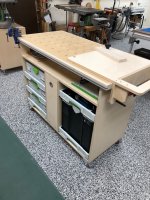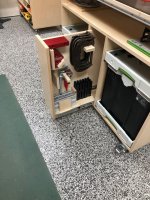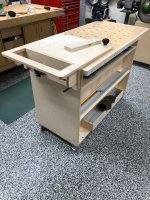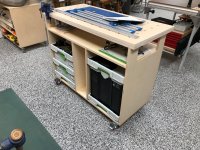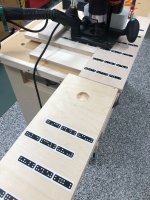Mario Turcot
Member
- Joined
- Nov 26, 2017
- Messages
- 1,247
I will receive the UJK Parf Guide System today and plan to work on a custom MFT this weekend. The MFT will be 910mm(~36") x 1520(~60") I'm like an ape with 810mm(~32") reach should I go deeper?
I have some real use questions and would like inputs from current MFT/3 users.
The Top;
I hate working with MDF and plan to use Baltic Birch. I am aware about potential chip out when drilling ply and will use crap board to prevent chipping.
1) Any concern about using BB?
2) Should I use 18mm or 24mm?
3) Obviously the dog holes will be 20mm, do the Festool quick/crew clamps will work fine with 24mm or 18mm is the only alternative?
The Profile;
My understanding is that the profile is a handy way to hold boards vertically using the quick/screw clamps.
4) Do the profile utility goes beyond my understanding?
5) I watched [member=1854]Dave[/member] Stanton and his Stanton woodworking workbench videos and he add an apron/skirt with a few rows of dog holes, is that approach more flexible?
The Dog Holes Pattern;
I am not yet decided about the dog holes pattern. I will wax/seal the top then run series of 3mm holes across the entire top.
6) I want to use a wipe on sealer, what sealer do you suggest?
7) In your experience what is the most used pattern?
Under the Hood;
Like I never use an MFT I am wondering if the need for reach under the table is important.
8) How often you use dog knobs or any other accessories that require you to access under the table?
9) The MFT will sit on a Torsion Box table, based on question #8 do 130mm(~5") space between the two tops will suffice? This will also guide question #5.
10) Any other aspect I should consider?
Any picture of yours(I mean your MFT [tongue]) would be awesome.
Thanks,
I have some real use questions and would like inputs from current MFT/3 users.
The Top;
I hate working with MDF and plan to use Baltic Birch. I am aware about potential chip out when drilling ply and will use crap board to prevent chipping.
1) Any concern about using BB?
2) Should I use 18mm or 24mm?
3) Obviously the dog holes will be 20mm, do the Festool quick/crew clamps will work fine with 24mm or 18mm is the only alternative?
The Profile;
My understanding is that the profile is a handy way to hold boards vertically using the quick/screw clamps.
4) Do the profile utility goes beyond my understanding?
5) I watched [member=1854]Dave[/member] Stanton and his Stanton woodworking workbench videos and he add an apron/skirt with a few rows of dog holes, is that approach more flexible?
The Dog Holes Pattern;
I am not yet decided about the dog holes pattern. I will wax/seal the top then run series of 3mm holes across the entire top.
6) I want to use a wipe on sealer, what sealer do you suggest?
7) In your experience what is the most used pattern?
Under the Hood;
Like I never use an MFT I am wondering if the need for reach under the table is important.
8) How often you use dog knobs or any other accessories that require you to access under the table?
9) The MFT will sit on a Torsion Box table, based on question #8 do 130mm(~5") space between the two tops will suffice? This will also guide question #5.
10) Any other aspect I should consider?
Any picture of yours(I mean your MFT [tongue]) would be awesome.
Thanks,

